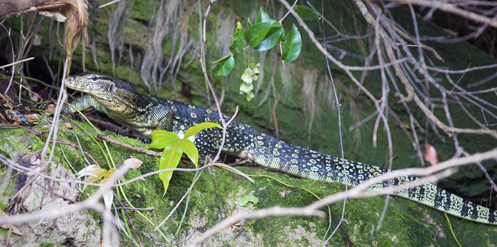September 14, 2018
Meet the Asian Water Monitor (Varanus Salvator), a lizard which belongs to the Varanidae family, which comprises nearly 80 species of monitor lizards.
This reptile is native to and commonly found throughout South and Southeast Asia, including Indonesia where is it called Biawak Air (which translates into ‘water lizard’).
Within the Restorasi Ekosistem Riau (RER) area, the Asian Water Monitor is a common species which can typically be seen.
The Asian Water Monitor can grow up to 1.5m in length and weigh up to 50kg, and it said to be the world’s second-heaviest lizard, after the Komodo dragon. Males are typically larger than females.
There are many colour variations of these water monitors, but they are normally dark brown or black, with yellow spots on their underside which gradually disappear with age. They also have a black band (with yellow edges) extending from the back of each eye.
Asian Water Monitors are muscular, with long necks and powerful jaws. These jaws, along with its saw-like teeth and sharp claws, help it both in predation and defence.
They are aggressive animals and extreme carnivores, feeding on fish, frogs, rodents, birds, crabs, snakes, turtles and young crocodiles.

The Asian Water Monitor is also a known scavenger who will eat the decaying flesh of dead animals – even dead human bodies. In the absence of specialist scavengers like vultures in dense, south Asian tropical rainforests, monitor lizards are among the species that play important roles in ‘cleaning up’ the forest.
It has a keen sense of smell and is capable of smelling a carcass from a distance, aided with a blue forked tongue that it darts in and out of its mouth to detect scents – just like a snake.
The Asian Water Monitor can stay in various habitats, although habitats which are most preferable to this species are forest mangrove areas, swamps and wetlands.
It is an excellent swimmer, often spending the night in the water. It is additionally capable of scaling trees using its powerful legs and claws, though it does not tend to climb too high up. It may jump from trees into streams in a bid to escape predators.
Young monitors, on the other hand, rarely climb trees despite having the capability to do so. This is because being on tree tops would make them vulnerable to birds of prey, especially serpent eagles. Instead, young monitors find safety inside dens, hollows, cracks or beneath tree roots.
Human presence is not a deterrent to Asian Water Monitors – this species has been observed to adapt and thrive in agricultural areas.
Breeding season for these lizards begins in April and lasts until October. Large females may produce up to 40 eggs per year, usually laying them in available termite mounds. The eggs may also be deposited in self-created burrows.
Monitor lizards are the most common type of lizard which is exported from Southeast Asia. As such, the largest threat to this species is hunting by humans.
Water monitors are hunted for their skins which are primarily used to make shoes, belts, and handbags, while their meat may be eaten and their fat used in traditional medicine.
Despite this, Asian Water Monitors hold a Least Concern (LC) conservation status issued by the International Union for Conservation of Nature (IUCN). LC species are considered to be abundant.
However, the Asian Water Monitor is listed on Appendix II of CITES (Convention on International Trade in Endangered Species of Wild Fauna and Flora), an international agreement between countries which governs the international trade of wild animal and plant species.
CITES II species are those which are not necessarily threatened with extinction, but of which trade must be controlled in order to render their survival.
The Asian Water Monitor is among one of the 107 reptile and amphibian species which have been identified within the RER area.